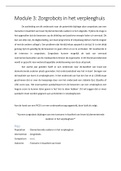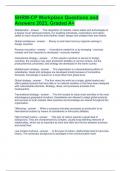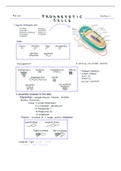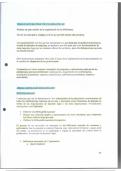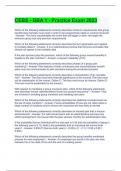1
,Content
Lecture 1 3
Providing CEOs with opportunities to cheat: The effects of complexity-based information asymmetries
on financial reporting fraud 4
Lecture 2 6
Fair pay or power play? Pay equity, managerial power and compensation adjustments for CEOs 6
Behavioural responses of CEOs to stock ownership and stock option pay 8
Does one size fit all? Investigating pay-future performance relationships over the “seasons” of CEO
tenure 10
Lecture 3 13
Does obfuscating excessive CEO pay work? The influence of remuneration report readability on say-on-
pay votes 13
Last dance or second chance? Firm performance, CEO career horizon and the separation of board
leadership roles 14
Strangers on the board: the impact of board internationalization on earnings management 16
Lecture 4 17
Boards of directors and firm performance: integrating agency and resource dependence perspectives 17
What’s the difference? Diversity, constructs as separation, variety, or disparity in organizations 19
Board informal hierarchy and firm financial performance: exploring a tacit structure guiding boardroom
interactions 21
Lecture 5 24
The audit committee: management watchdog or personal friend of the CEO? 24
Do investors care about director tenure? Insights from executive cognition and social capital theories 25
Marching to the beat of different drummers: the influence of institutional owners on competitive
actions 28
Shareholder protection: the role of multiple large shareholders 30
Agency conflicts and auditing in private firms 32
The effects of corporate governance on firms’ credit ratings 34
Lecture 6 36
The effect of board characteristics on firm environmental performance 37
Labour market evaluation versus legacy conservation: what factors determine retiring CEOs’ decisions
about long-term investment? 40
Top management conservatism and corporate risk strategies: evidence from managers’ personal
political orientation and corporate tax avoidance 42
Socioemotional wealth and corporate responses to institutional pressures: do family-controlled firms
pollute less? 43
2
,Lecture 1
Introduction
Corporate governance
Corporate governance is the system of directing and controlling a company. Also corporate governance is
defined as the ways in which suppliers of finance assure themselves of getting a return on their investment. It is
a structure through which the objectives of the company are set.
Agency theory
Agency theory is based on the idea of separation of ownership and control. It is the dominant perspective used
in the literature on corporate governance. In short, the basic idea is that the goals of owners and the goals of
managers do not align with each other. Managers do not always make decisions that are the best possible for
shareholders. They behave sub-optimally, though their purpose is to create shareholder value. This is called the
agency problem. Besides that, owners have a hard time verifying what managers are doing.
Possible causes for the agency problem are:
• Differences in goals between managers and owners;
• Information asymmetry (adverse selection & moral hazard);
• Complete contracts are not possible;
• The manager only bears part of the costs, he will get paid anyway;
• Owners are no capable of supervising the manager.
A manager can benefit from information asymmetry in two ways:
• Adverse selection: this information asymmetry exists when the manager is not yet hired and is
therefore ex ante;
• Moral hazard: this information asymmetry exists when the manager is already hired and is therefore ex
post.
Three important agency problems are:
• Decision-making: managers use their position to influence decision-making;
• Perks: managers use their position to assign themselves perks;
• Financial statement fraud: managers use their position to commit fraud.
Key solutions to mitigate agency problems are:
• Monitoring (by the board of directors);
• Incentive alignment (by rewarding the manager);
• The market for corporate control (governance mechanisms).
We can distinguish two kinds of agency costs. Bonding costs are the costs that managers make to convince
owners that they behave well. Monitoring costs are the costs that owners make to monitor managers. There will
always be some residual loss.
There are two agency theory perspectives:
• Substitution: corporate governance mechanisms can replace each other. This is the traditional
perspective. The presence of one mechanism assures effective governance;
• Complementarity: corporate governance mechanisms re-enforce each other. Effective governance
therefore requires the presence of more than one mechanism.
3
, Providing CEOs with opportunities to cheat: The effects of complexity-based information
asymmetries on financial reporting fraud
- Ndofor, Wesley & Priem (2015)
The research question in this paper is: “How does information asymmetry affect financial statement fraud and to
what extent do corporate governance mechanisms moderate this association?
Financial reporting fraud requires three simultaneous circumstances:
• Opportunity: the opportunity to deceive is a necessary precondition for fraud (information asymmetry);
• Motive: the perpetrator should have a reason for doing it (e.g. stock options);
• Willingness: the perpetrator should be willing to commit fraud.
The role of the CEO creates opportunities for fraud. This is caused by the separation of ownership from firm
control. This creates information asymmetries between CEOs and shareholders. CEO’s can engage in self-serving
behaviours and are subject to moral hazard, because:
• They know more about their firms’ resources and operations;
• The relationship between CEOs behaviours and outcomes is not clearly visible.
The agency problem is especially important for corporate governance, because firms’ top managers have more
and better information about the firms they lead than do owners. This allows managers to pursue strategic
actions that may disproportionally benefit management at the expense of stockholders. This leads to a moral
hazard risk for shareholders. Information asymmetry results in the potential for post-contract opportunism by
top managers. Two kinds of moral hazard arise:
1. Hidden actions: actions, behaviours and effect exerted by top managers are not always observable by
owners. Also cause-effect relationships in the firm are not always clear. Managers can therefore engage
in activities that benefit themselves;
2. Hidden knowledge: top managers have access to information about a firm’s operations that is not
available to shareholders. This is especially true for performance information, because this is subject to
manipulation.
Hypothesis 1
Factors that contribute to the degree of information asymmetry:
• Proximity: shareholders distance themselves from the firm and sacrifice any possibility for tacit
understandings of daily activities;
• Complexity in the firm: the more diversified a firm, the greater is its organizational complexity.
Managers can more easily distort internal operations, so that external parties have difficulty making
cause and effect attributions. Managers can also shift costs and revenues across units, because only the
financial information of the parent entity is released. Lastly, diversification leads to synergy. This
provides a grey area that obscures links between actions and firm performance;
• Complexity in the industry: complexity reduces transparency and increases uncertainty about actions
and their outcomes. More components can account for success and links between actions and
outcomes are not direct, linear or transparent. Firms competing in complex industries have higher
levels of information asymmetry.
Increases in complexity-based information asymmetries hide self-interested top management behaviours and
thereby increase the probability of financial reporting fraud:
➢ H1: The level of complexity-based information asymmetry between a firm’s top managers and
shareholders is positively related to the likelihood of fraudulent financial reporting by the firm’s top
managers.
4

